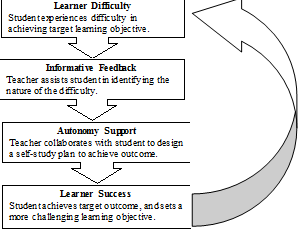|
Ushioda (2013) asserted, “Motivation is widely recognized as a
significant factor influencing success in second or foreign language
(L2) learning, and is perhaps one of the key variables that
distinguishes first language acquisition from second language
acquisition” (p. 1). Therefore, one can assume that “skills in
motivating learners should be seen as central to teaching effectiveness”
(Dornyei & Csizer, 1998, p. 207). Teachers need to understand
the different types of, and factors affecting, motivation, and employ a
model of intervention that enhances learners’ motivation.
Educators often think of extrinsic rewards, which instructors
have no control over, as being the primary motivators of language
learning. However, Noels, Clement, and Pelletier (1999) found that
“stronger feelings of intrinsic motivation were related to positive
language learning outcomes…Moreover, perceptions of the teacher’s
communicative style were related to intrinsic motivation, such that the
more controlling and the less informative students perceived the teacher
to be, the lower students’ intrinsic motivation was” (p. 23; see also
Dornyei, 2005).
Learner autonomy increases by “perceiving that their learning
successes and failures are to be attributed to their own efforts and
strategies rather than to factors outside their control” (Dickinson,
1995, 173–74). One way teachers can support learner autonomy and
improve their level of attributions to their own efforts is through
instructing students in methods of self-regulation (Kormos &
Csizer, 2013). There is some debate about the causal relationship
between motivation and autonomy, as “motivation may lead to autonomy or
be a precondition for it” (Spratt, Humphreys, & Chan, 2002, p.
262). The Iterative Intervention Model for Enhancing Learner Intrinsic
Motivation (see Figure 1) is a way to apply the preceding theoretical
concepts related to intrinsic motivation in a practical methodology L2
teachers can use in a wide variety of contexts. There are three basic
types of intrinsic motivation: IM-Knowledge, IM-Accomplishment, and
IM-Stimulation (Noels, Pelletier, & Vallerand, 2000). The model
addresses all three types by including informative feedback and
supporting learner autonomy in stimulating ways, and acknowledges that
motivation and autonomy have a relationship that is not one
directional.
References
- Dickinson, L. (1995). Autonomy and motivation: A literature
review. System, 23(2),165-174.
- Dornyei, Z. (2005). The Psychology of the Language
Learner: Individual Differences in Second Language
Acquisition. New York: Routledge.
- Dornyei, Z. & Csizer, K. (1998). Ten commandments for
motivating language learners: results of an empirical study. Language Teaching Research, 2(3), 203-229.
- Kormos, J. & Csizer, K. (2013). The interaction of
motivation, self-regulatory strategies, and autonomous learning behavior
in different learner groups. TESOL Quarterly, 0(0),
1-25.
- Noels, K.A, Clement, R., & Pelletier, L.G. (1999).
Perceptions of teachers’ communicative style and students’ intrinsic and
extrinsic motivation. Modern Language Journal, 83(1), 23-34.
- Noels , K.A, Pelletier, L.G., & Vallerand, R.J.
(2000). Why are you learning a second language?: Motivational
orientations and self-determination theory. Language Learning,
50(1), 57-85.
- Spratt, M., Humphreys, G., & Chan, V. (2002).
Autonomy and motivation: Which comes first? Language Teaching
Research, 6(3), 245-266.
- Ushioda, E. (2013). Motivation and ELT: Global issues and
local concerns. In E. Ushioda (Ed.). International perspectives
on motivation: Language learning and professional challenges
(pp. 1-17). Palgrave Macmillan.

Figure 1
|

